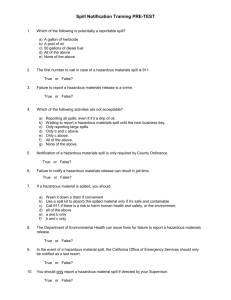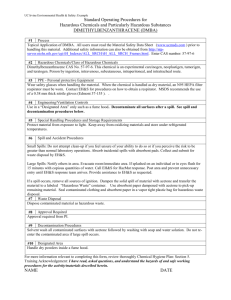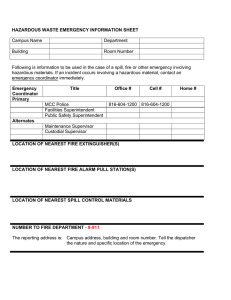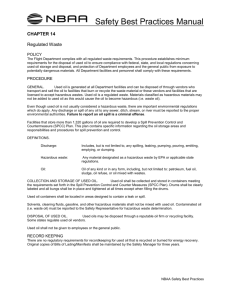Hazardous Material Spill Identification
advertisement
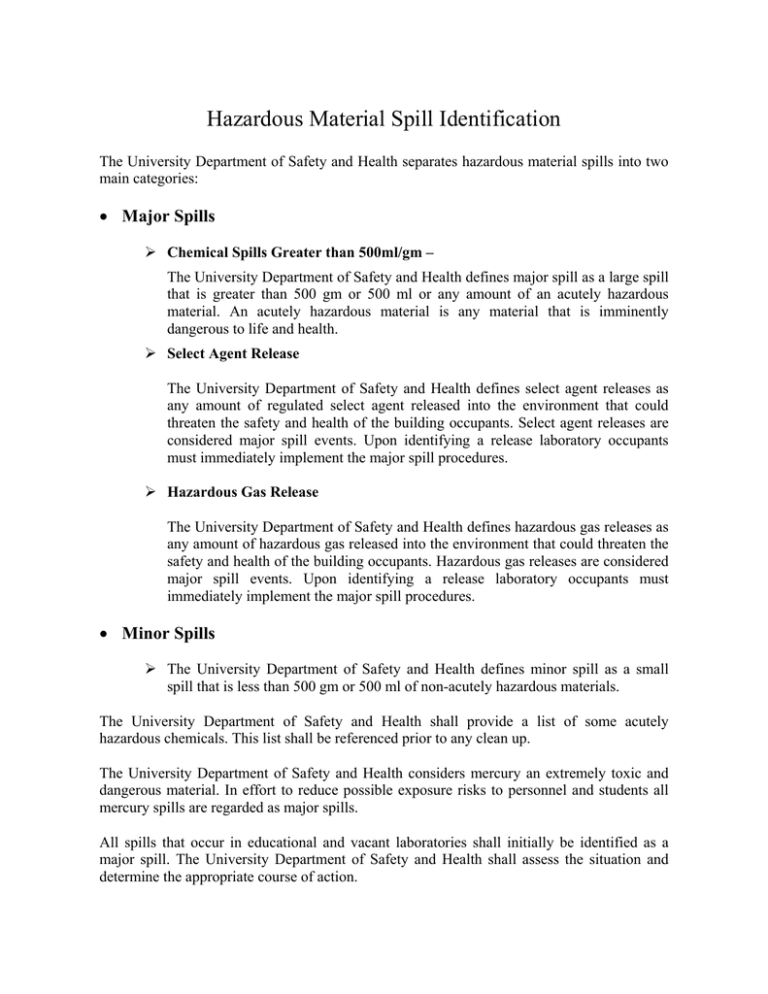
Hazardous Material Spill Identification The University Department of Safety and Health separates hazardous material spills into two main categories: • Major Spills ¾ Chemical Spills Greater than 500ml/gm – The University Department of Safety and Health defines major spill as a large spill that is greater than 500 gm or 500 ml or any amount of an acutely hazardous material. An acutely hazardous material is any material that is imminently dangerous to life and health. ¾ Select Agent Release The University Department of Safety and Health defines select agent releases as any amount of regulated select agent released into the environment that could threaten the safety and health of the building occupants. Select agent releases are considered major spill events. Upon identifying a release laboratory occupants must immediately implement the major spill procedures. ¾ Hazardous Gas Release The University Department of Safety and Health defines hazardous gas releases as any amount of hazardous gas released into the environment that could threaten the safety and health of the building occupants. Hazardous gas releases are considered major spill events. Upon identifying a release laboratory occupants must immediately implement the major spill procedures. • Minor Spills ¾ The University Department of Safety and Health defines minor spill as a small spill that is less than 500 gm or 500 ml of non-acutely hazardous materials. The University Department of Safety and Health shall provide a list of some acutely hazardous chemicals. This list shall be referenced prior to any clean up. The University Department of Safety and Health considers mercury an extremely toxic and dangerous material. In effort to reduce possible exposure risks to personnel and students all mercury spills are regarded as major spills. All spills that occur in educational and vacant laboratories shall initially be identified as a major spill. The University Department of Safety and Health shall assess the situation and determine the appropriate course of action. Hazardous Material Spill Procedures for Major Spills The following procedure applies to: • • • • • • Laboratory personnel Education personnel Maintenance personnel Outside Contractor Personnel Environmental Services personnel Administrative personnel In the event of a major spill in a university area, all laboratory, education, maintenance, outside contractor, administrative, and/or environmental services personnel will implement the following plan: 1. 2. 3. 4. Notify persons in the immediate area that a spill has occurred. Avoid breathing vapors, mists or dust of the spilled material. Turn off all ignition sources if reasonably accessible. If injured or contaminated with hazardous chemicals immediately proceed with personal decontamination procedures. 5. Evacuate room and close the door. 6. From a safe area, contact the following using any in house telephone: Campus Public Safety Dispatcher Emergency Operator Center City Queen Lane University City Delaware Valley 215-895-2222 215-895-2222 215-895-2222 215-895-2222 Dial “80” Dial “80” ----------------------------------------------------- 7. In order to asses the situation be prepared to provide the following information: • • • • Name and call back number The location of the spill (campus, building and room number) Type of material spilled The amount of material that spilled 8. Remain on or near the telephone until you have received instructions from the emergency operator or Public Safety or Security or the University Department of Safety and Health. Hazardous Material Spill Procedures for Minor Spills In the event of a minor spill the following emergency procedures shall be implemented: 1. If injured or contaminated with hazardous substances immediately proceed with personal decontamination procedures. 2. Laboratory personnel will be responsible for the containment and clean up of all minor spills. 3. Proper personal protection equipment shall be donned during the clean up of all minor spills. If the laboratory occupants do not have the proper personal protective equipment then contact the University Department of Safety and Health for assistance at 215-7622318 or 215-778-4278 or 215-762-3719 or Public Safety at 215-895-2822 to contact a representative from the University Department of Safety and Health. 4. All non-disposable personal protective equipment shall be decontaminated and stored. 5. All disposable personal protective equipment and clean up materials shall be disposed of as hazardous waste. 6. If the material spilled is not covered under the minor spill definition (< 500 gm or 500 ml of non-acutely hazardous material) then laboratory personnel shall implement the major spill procedures. Education and Vacant Laboratories: All minor spills occurring in vacant laboratories, education/prep laboratories, or any other university area shall be considered a major spill. Therefore, anyone observing a minor spill in these areas shall implement the major spill procedures. Personal Decontamination Procedures Please be advised that these procedures are general decontamination procedures. These procedures might not be appropriate for certain types of hazardous materials. In effort to ensure proper decontamination consult the Material Safety Data Sheet prior to conducting any experiments. If injured or contaminated with a hazardous substance these procedures will be implemented immediately prior to cleaning up or reporting spill. • For spills contacting the of skin, follow these procedures: 1. Immediately flush with flowing water for at least 15 minutes (i.e. sink or safety shower). 2. If there is no visible burn, wash with warm water and soap, removing any jewelry to facilitate clearing of any residual material. 3. Check the material safety data sheet to see if any delayed effects should be expected. If the MSDS is not available contact the University Department of Safety and Health immediately at 215-762-2318 or 215-778-4278 or 215-762-3719 or go to www.hazard.com. 4. Seek medical attention for even minor chemical burns. 5. Do not use creams, lotions, or salves. • For spills on clothing, follow these procedures: 1. 2. 3. 4. 5. Do not attempt to wipe the clothes. Quickly remove all contaminated clothing, shoes, and jewelry while using the safety shower. Seconds count, so do not waste time because of modesty Take care not to spread the chemical on the skin or, especially, in the eyes. Use caution when removing pullover shirts or sweaters to prevent contamination of the eyes; it may be better to cut the garments off. 6. Immediately flood the affected body area with warm water for no less than 15 minutes. Resume if pain returns. 7. Get medical attention as soon as possible. 8. Discard contaminated clothes as hazardous waste or have them laundered separately from other clothing. • For splashes into the eye, take these steps: 1. Using the eyewash immediately flush for at least 15 minutes. 2. Hold the eyelids away from the eyeball, and move the eye up and down and sideways to wash thoroughly behind the eyelids. 3. Get medical attention immediately. Follow first aid by prompt treatment by a member of a medical staff or an ophthalmologist who is acquainted with chemical injuries. Spill Clean up Procedures In the event of a spill, the laboratory personnel will implement the following clean up procedures: 1. Proper personnel protection equipment will be donned during clean up of all hazardous materials. Personnel protection equipment compatibility charts will be referenced prior to cleaning up any spilled material(s). If the laboratory personnel does not have the proper personal protective equipment then contact the University Department of Safety and Health for assistance at 215-762-2318 or 215-778-4278 or Public Safety at 215-895-2822 to contact a representative from the University Department of Safety and Health. 2. Contain spilled material(s) using absorbent pads and/or socks. Paper Towels will not be used for containment of spill nor will they be used for clean up. 3. Neutralize spilled material(s) using the appropriate neutralizing agent. 4. Clean up neutralized material using dustpan and/or plastic scoop. 5. Place neutralized material in hazardous waste bags. Dispose of as hazardous waste. 6. Wash area where spill has occurred with distilled water several times making sure no residue was left behind. Dispose of any towels used as hazardous waste. 7. All emergency equipment shall be decontaminated and stored. 8. All non-disposable personal protective equipment shall be decontaminated and stored. 9. All disposable personal protective equipment and clean up materials shall be disposed of as hazardous waste. 10. Always use extreme caution when cleaning up hazardous substances. University City Campus - Emergency Contact Numbers Department Public Safety Emergency Room Student Health Occupational Health Univ. Safety Univ. Safety Univ. Safety Univ. Safety Univ. Safety Univ. Safety Radiation Safety Facilities Maintenance Environmental Services Name HUP Drexel HUP Jon Chase Armour Floyd Phil Leo Phil Leo Jen Nichols Diana Dukes Kent Lambert Office Number 215-895-2222 215-662-3920 215-895-5800 215-622-2354 215-762-6506 215-762-1098 215-762-2318 215-762-1102 215-762-7624 215-762-3632 215-762-4050 215-895-2808 215-895-2808 215-895-2808 Mobile Number Pager Number 215-669-6122 215-768-1617 215-778-4278 215-768-1624 215-768-1623 215-778-4279 Center City Campus - Emergency Contact Numbers Department Emergency Operator Emergency Room Student Health Occupational Health Univ. Safety Univ. Safety Univ. Safety Univ. Safety Univ. Safety Univ. Safety Hospital Safety Hospital Safety Radiation Safety Facilities Security Maintenance Environmental Services Name HUH Jon Chase Armour Floyd Martin Bell Phil Leo Jennifer Nichols Diana Dukes Luis Gonzalez John Wierzbowski Kent Lambert Patricia Lewis Office Number 80 215-762-7963 215-762-8590 215-762-8590 215-762-6506 215-762-1098 215-762-2318 215-762-1102 215-762-1624 215-762-3632 215-762-1458 215-762-3737 215-762-4050 215-762-6500 215-762-7110 215-762-3000 215-762-4700 Mobile Number 215-669-6122 215-768-1617 215-778-4278 215-768-1624 215-768-1623 215-778-4279 267-254-2471 215-783-2672 Pager Number 4-2830 4-1447 4-1260 4-1015 Queen Lane Campus - Emergency Contact Numbers Department Emergency Operator Public Safety Student Health Occupational Health Univ. Safety Univ. Safety Univ. Safety Univ. Safety Univ. Safety Univ. Safety Radiation Safety Facilities Security Maintenance Environmental Services Name Jon Chase Armour Floyd Martin Bell Phil Leo Jen Nichols Diana Dukes Kent Lambert Ray Stoffel Office Number 80 215-895-2222 215-895-5800 215-762-8590 215-762-6506 215-762-1098 215-762-2318 215-762-1102 215-762-7624 215-762-3632 215-762-4050 215-991-8484 215-991-8102 215-991-8145 215-991-8145 Mobile Number Pager Number 215-669-6122 215-768-1617 215-778-4278 215-768-1624 215-768-1623 215-778-4279 4-1260 215-651-1321 Delaware Valley Campus - Emergency Contact Numbers Department Security 24 Hour Call Center Emergency Room Student Health Occupational Health Univ. Safety Univ. Safety Univ. Safety Univ. Safety Univ. Safety Univ. Safety Radiation Safety Facilities Maintenance Environmental Services Name Jon Chase Armour Floyd Martin Bell Phil Leo Jen Nichols Diana Dukes Kent Lambert Tom Beal Tom Beal Tom Beal Office Number 215-489-2315 215-895-2222 215-762-6506 215-762-1098 215-762-2318 215-762-1102 215-762-7624 215-762-3632 215-762-4050 215-489-4904 215-489-4904 215-489-4904 Mobile Number 215-669-6122 215-768-1617 215-778-4278 215-768-1624 215-768-1623 215-778-4279 Pager Number

